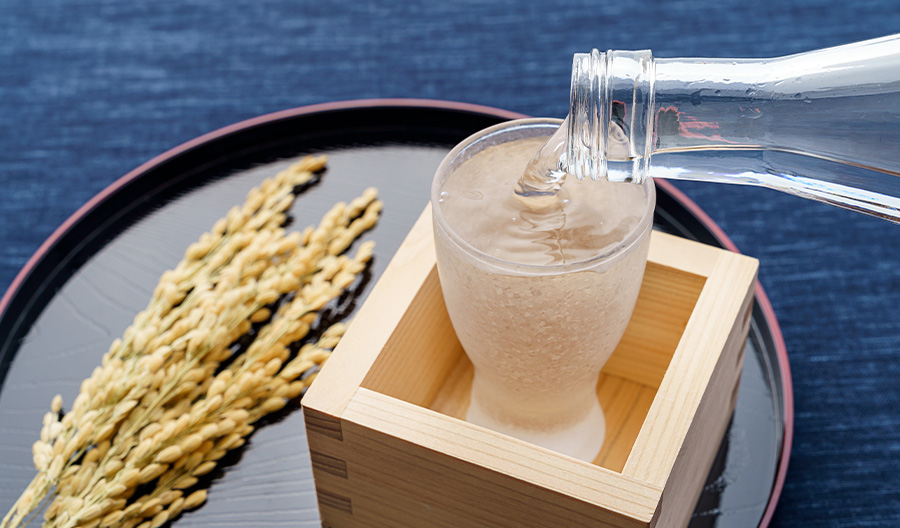Back when George Padilla worked at a wine store, staff held a party at a BYOB Jamaican restaurant. After his co-workers showed off the Rieslings and such they’d brought, Padilla distributed ochokos, or earthenware cups, and poured from a Thermos a warm yamahai saké, a structured, umami-driven brew fermented at a high temperature to naturally produce lactic acid.
“It was a lights-out moment,” says Padilla, co-owner of the Brooklyn restaurant Rule of Thirds and the saké shop Bin Bin. The sake’s comforting temperature and underlying sweetness mellowed the spice of the evening’s jerk chicken, while its flavor boosted the meat’s savoriness. The pairing revealed the versatility and power of a beverage we often think of in rigid terms.
Japan’s rice-based brew, say experts, works hot or cold, for fine dining or snacking, in a wine glass or ceramics, and beyond. You just need to learn some guidelines. Then, once you’ve mastered them, you can throw them away.
Find the Right Food for Your Saké
We usually think of wine when pairing drinks with food, but its acidity and tannins can present challenges that saké does not. Red and white wines contain at least five times more acidity than saké, according to the Sake School of America. “Saké is… less aggressive, so food enhances its flavor,” notes Paul Willenberg, a saké importer.
In other words, saké bends to food’s taste more easily than wine. When pairing saké with food, Padilla thinks in terms of intensity.
“How ‘loud’ or ‘soft’ does the food present? Match the sake to that level,” he says. When those “volumes” are in balance, sake’s umami notes act as a bridge between bites. That’s what happens at an izakaya, a style of Japanese tavern that often serves plenty of salty, fermented dishes to keep patrons sipping. The salt, notes Willenberg, increases sake’s texture and binds with its subtle acidity to create more umami flavor, which helps dishes taste good.
Indeed, saké and salt are “best friends,” says Monica Samuels, vice president of sake and spirits for Vine Connections and a Sake Samurai, a title conferred by the Japan Sake Brewers Association. She likes saké with chips, popcorn and bar nuts.
But different styles of saké do have ideal partners for meals. Heartier foods tend to go with savory junmai, which is made from rice polished to 70% of the grain’s original size. Traditional sakés like kimoto, a style in which the yeast starter is beaten to kickstart lactic fermentation, have the structure to support umami-driven foods. Meanwhile, caramelly and funky koshu, or aged saké, works well with similarly intense aged cheeses, not to mention Thanksgiving’s flavor bomb of gravy-smothered turkey and pumpkin pie.
Nigori saké, which is characterized by rice particles that cloud and sweeten it, tolerates bold flavors and spice a la dishes like Korean fried chicken, birria and vindaloo. As for unpasteurized spring sake, or nama saké, which boasts a thicker texture and brasher aroma relative to other styles, is a match for hefty, creamy pastas, tangy cheeses and grilled meats.
Bright, fragrant ginjo and daiginjo sakes—a k a offerings made with rice polished to 60% or greater—complement lighter, simpler foods that won’t obscure their delicate aromas, like salads and sashimi. As for sparkling sakés, which can range from sweet to bone-dry? Their thicker texture does well with playful pairings like potato chips and caviar.

“Those are the wines I used to buy, ones that could transport my guests somewhere else and that had a good backstory to amuse and educate,” he says.
Hickey counts his Nero d’Avola as the wine that set his trademark winemaking aesthetic. He planted the heat-happy Italian grape in McLaren Vale, then went to Sicily to research vinification techniques.
“Nobody [in McLaren Vale] that I knew had made wine in terracotta, so it was a new thing,” he says. “I decided to keep the wine on skins for six months, all of fall and winter, and to keep any sulfur to a bare minimum.” He now considers that sort of slow, thoughtful winemaking a hallmark of his style.
Not filtering the wines is also key to Hickey’s process. “For the most part, wine will naturally clarify over time,” he says, but he’s not adverse to a little cloudiness in the bottle.
A true unfiltered saké
Probably the most misunderstood unfiltered beverage is saké. Contrary to popular belief, cloudy nigori saké is filtered, as it can go through a coarse filter and retain some of the rice particles. But often, brewers press the liquid to separate it from the saké lees, and then reintroduce the solids. However, there’s a style of unfiltered saké called muroka that’s gained traction with brewers.
“Saké was secondary to food in Japanese culture until very recently,” says Monica Samuels, director of saké and spirits at Vine Connections. “The best thing you could say about saké is that it’s not going to interfere with food. Saké was meant to be innocuous: light, clean and water-white in color.”
Saké’s crystalline tone can be achieved with charcoal filtration, a process known as roka, but some brewers consider it cheating.
“If you’re making your saké with a lot of precision, it should come out of the tank looking really good without having to add charcoal to take out the color,” says Samuels. “Saké that is muroka often has a touch of color, generally in the lemon-to-gold range, and a rusticity that is richer than when charcoal is added.”
Although not a legally defined term, muroka is often listed on labels alongside words that denote more powerful and intense styles of saké, like yamahai or genshu.
“The more I asked consumers why they wanted to drink nigori, they said, ‘Well, it’s better for you, right?’” says Samuels. “They think it’s more natural and more like unfiltered wine, where nigori often has an extra step involved: press off the liquid and add the solids back in. So, if people are looking for something with less intervention, nigori sakés are not that, where muroka is.”

